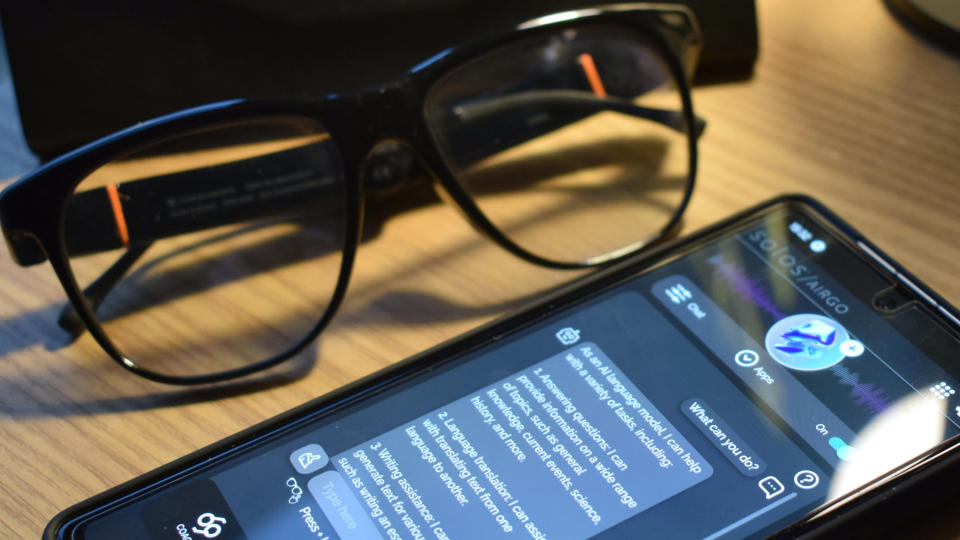What are smart glasses? Yesteryear’s ‘next big thing’ is finally finding an audience

Wearable tech has become commonplace in the digital age as everything from watches to rings receive ‘smart’ overhauls that unlock a slew of new functions for familiar forms, from tracking health metrics to more conveniently interacting with other devices. However, while we can all recognize an Apple Watch, we may be less familiar with other forms of wearable — particularly, smart glasses.
There's good reason for such oversight too. On their initial release into the wilds of the commercial market, smart glasses were more prone to jeers and jibes than shock and awe.
As a glasses wearer, it's plainly obvious to me that my regular frames are bursting with untapped potential.
While the tech was impressive, they were often seen as little more than an expensive status symbol for the tech-obsessed, and a genuine threat to the privacy of anyone not positioned behind their lenses. However, as times have changed, so too have attitudes, and a smart glasses renaissance could be primed to explode in popularity in the very near future.
What makes smart glasses important? Well, when it comes to finding a wearable that can do it all, the answer for many of us is right in front of our faces. Literally. While glasses have helped correct vision for centuries, their form and position on the body make them ideal for providing visual and audio feedback in the most unobtrusive and accessible way possible.
I’m a huge proponent of smart glasses and have been for some time now. As a glasses wearer, it's plainly obvious to me that my regular frames are bursting with untapped potential — and several of my experiments with smart glasses have shown me that they’re more than capable of housing all kinds of wonderful tech too.
So, let’s take a deeper look at what smart glasses are and some of the frames we’d recommend you become familiar with.

What are smart glasses?
Smart glasses, like regular glasses, are face-worn eyewear that can not only help correct vision but also offer additional functionality. They can interact with your other smart devices and computers or work stand-alone to provide media playback, activity tracking, and more.
Although they’ve been around since 2004, they’re only truly beginning to make their presence known in the mainstream.
Why check your phone for notifications when you can be alerted through a heads-up display (HUD)? Why rely on physical screens when you can project content directly in front of your eyes and all around you with augmented reality (AR)? And why let a phone call interrupt you when you can use your smart glasses to receive calls completely hands-free?
Smart glasses offer a new way of being connected to your favorite tech. Although they’ve been around since 2004, they’re only truly beginning to make their presence known in the mainstream. While Google tried its hand at the format in 2014, a generally negative reaction to its camera-adorning frames set the consumer viability of these devices back for some time.
However, consumer attitudes have started to shift. Despite several high-profile flops, wearables are now commonplace (remember, Google Glass was unveiled even before the very first Apple Watch launched), smart glasses sales are currently predicted to double year-over-year, Meta’s latest smart glasses have proven to be a surprise success, and the growing popularity of AR and AI has given the smart glasses form factor rejuvenated use cases — even Apple is pondering making pair of smart glasses of its own according to one Bloomberg report.
The market is now more welcoming than ever to wearables of this sort, with smart glasses morphing into a much more attractive prospect due to the many useful features and capabilities they can offer.

What types of smart glasses are there?
While smart glasses aren’t exactly commonplace, there are a considerable number of manufacturers dedicated to designing frames that offer all kinds of advanced functions.
Because of this, there’s no universal example of what a pair of smart glasses must include to be considered as such. However, a majority of smart glasses fall within one or more of the following categories:
Smart glasses for media capture: Mirroring the spy glasses of espionage novels, but hopefully not abused for creepshot potential, some devices like the Ray-Ban Meta smart glasses use built-in microphones and cameras to capture images and video from a first-person point of view.
These frames are great for those looking to capture some social media snaps, though you’ll need a mirror handy if you’re interested in taking the perfect selfie.
Smart glasses for communication: One of the more basic smart glasses variants are those designed to replace hands-free headsets for inbound and outbound phone calls.
While they lack any of the more fancy display or AR/XR capabilities of premium models, these smart glasses are generally much more affordable and offer built-in microphones and open-ear audio for music playback and call handling.
Smart glasses for AI: Tech’s latest craze is undoubtedly AI, and there’s a push to infuse large language models (LLMs) into just about every product there is. However, when it comes to smart glasses, there may be no better home for a super-intelligent assistant.
With multi-modal AI models now fairly common, smart glasses like the Solos AirGo 3 and AirGo Vision offer unique ways to use AI to interact with the world around you using contextual voice, text, and visual information.
Smart glasses for AR/XR: Augmented (or mixed) reality glasses are among the more expensive options on the market. They provide a virtual display for mobile and desktop devices.
AR smart glasses like the XREAL Air 2 and VITURE Pro XR are also equipped with head tracking sensors capable of providing 3DoF (Three Degrees of Freedom) to floating AR windows. With the right accessories, glasses like these can also offer 6DoF tracking similar to Meta Quest 3 and Apple Vision Pro headsets.

Outlook: Are smart glasses the future?
Call me biased, but as I sit here wearing a pair of smart glasses myself, I can say with certainty that these devices are incredibly useful and packed with potential. A pair of lightweight AR glasses can turn a simple laptop into a multi-screen workstation, while others give you instant access to some of the most powerful AI models for real-time assistance.
While several of the more popular AR models excel at delivering compelling entertainment experiences in 2D and 3D media, the potential of smart glasses isn’t limited to the living room.
Call me biased, but as I sit here wearing a pair of smart glasses myself, I can say with certainty that these devices are incredibly useful and packed with potential.
As the display tech evolves and software improves, smart glasses will offer more compelling visual aids for navigation, offer real-time visual translation of languages, and adopt hand tracking for more advanced interactions with richer interfaces and AR elements. We’re already seeing the latter take shape with XREAL’s latest Air 2 Ultra glasses.
The potential for this tech is unrivaled among its wearable contemporaries, and we’re even beginning to see screenless AR laptops outfitted with smart glasses enter the market — fully banking on the future of spatial computing.
Are smart glasses a guarantee to take the tech world by storm? Well, that’s not so easy to say. Sometimes, even the best ideas don’t catch on. However, as the buzz around these devices grows, along with their capabilities and performance, I’d personally say that spatial computing in all of its forms is here to stay, and smart glasses are the best and most obvious way for it to thrive.
